Air pollution project harnesses the power of backyard science

This past year, a handful of motivated Fort Collins citizens did something a little out of the ordinary: They collected cutting-edge scientific data from their backyards that may soon help NASA create global maps of air pollution.
The volunteers were part of a network of citizen scientists for a NASA-funded, Colorado State University-led project called . In recent months, the project received the green light for full speed ahead. Following a successful pilot phase in Fort Collins, NASA has re-funded CEAMS to the tune of $1.6 million over the next three years. That means recruiting more citizen scientists across Denver, the Northwest, and Los Angeles.
The goal of CEAMS is to improve understanding of local air quality through dispersed, ground-based measurements. Data on this scale could eventually help NASA satellites provide higher-resolution air quality data than is possible today.
“NASA is interested in solving global problems,” said CEAMS leader John Volckens, CSU Energy Institute researcher and professor of mechanical engineering. “Most governments can’t afford to monitor air pollution at all. Yet, air pollution is a leading cause of death and disease on the planet – responsible for more deaths worldwide than HIV and malaria combined.”
Air pollution monitoring is a tricky and expensive business, according to Volckens. In the U.S., the Environmental Protection Agency maintains about 1,000 active air samplers for fine particulate matter air pollution across the country – about one for every three counties. But pollution from vehicles, power plants, wildfires, and a host of other sources varies at much finer spatial scales than the county level.
NASA uses a combination of satellite imaging and computer algorithms to model air pollution, but models can say only so much about details of ground-level air quality. That’s where the CSU team comes in.
“If we want to develop better algorithms to make the air quality maps from satellite images more representative, we need more data on the ground,” Volckens said. “This project is designed to develop those datasets.”
Smaller, cheaper, and more of them
Typical EPA monitors that detect particulate matter smaller than 2.5 microns, or “PM 2.5,” cost about $30,000 each and are complicated to run. The CSU CEAMS effort is focused on distributing a large number of compact, low-cost, solar-powered instruments that can be deployed in backyards by volunteers. And with many hands making light work, the scientists can collect better, more high-resolution data on the local scale than any satellite could from outer space.
“If we establish a network with 100 monitors across a metro area, we will have access to an incredibly powerful dataset that NASA can use to improve maps of air quality,” says Jeff Pierce, associate professor of atmospheric science and co-investigator on the project.
The CEAMS sensors take two primary types of measurements. One is aerosol optical depth, or AOD, which is related to the amount of particulate matter present in a vertical column of air from Earth to space. The other is ground-level PM 2.5, which is of most concern for human health. “These two measures, taken together, are valuable not just to NASA but to anyone interested in local air quality,” says Eric Wendt, a graduate student in mechanical engineering who helped design the sensor.
The interdisciplinary team, involving engineers, atmospheric scientists, and social scientists, are all members of the CSU Partnership for Air Quality, Climate, and Health – an organization that synergizes expertise at CSU to deliver solutions to societal problems at the intersection of air quality, climate, and health. The PACH team was created in response to the Office of the Vice President for Research’s Catalyst for Innovative Partnership program, which seeks to solve global challenges using interdisciplinary science. The CEAMS team, a subset of PACH, includes Volckens, Pierce, and co-investigators Shantanu Jathar of mechanical engineering and Marilee Long of journalism and media communication, as well as members of their research groups.
Long’s role is helping determine best practices for recruiting and training citizen scientists. “Citizen science isn’t about just using people to make scientific measurements,” she said. “There is a value to them as well. If we have a lot of people out there learning, we’re also encouraging them to think positively about science. Their feedback also helps us design better instruments for future volunteers.”
Tapping a homegrown network
Luckily for the CEAMS team, they had access to a ready-made, homegrown citizen science network: the snow and rain spotters who collect precipitation data for the Community Collaborative Rain, Hail and Snow Network, CoCoRaHS, through the Colorado Climate Center. The center staff connected CEAMS managers with local citizens willing to volunteer for the air pollution project.
The providing step-by-step instructions on how to set up the monitors and collect data. Team member Casey Quinn, a graduate student in the Department of Environmental and Radiological Health Sciences, created a smartphone application through which the citizen scientists upload their data directly to the CEAMS team.
In Fort Collins, volunteers were asked to take a sample every two days for about two weeks. Thanks to feedback from their pilot volunteers, the researchers plan several improvements for the samplers when they expand into other cities. These include increasing wireless capabilities for data management and adding a reflective bead to help ensure the sensors are properly aligned.
Apple features CSU air pollution research
Technology giant Apple launched a new podcast channel last year called Higher Education Stories. Its inaugural episode featured CSU’ s air pollution researchers, led by John Volckens.
The story can be viewed via Apple iTunes.

Anne Manning
Communications Coordinator